Trapwing Prototype
Printed From: Yachts and Yachting Online
Category: Dinghy classes
Forum Name: Dinghy development
Forum Discription: The latest moves in the dinghy market
URL: http://www.yachtsandyachting.com/forum/forum_posts.asp?TID=6709
Printed Date: 07 Jul 25 at 1:02pm
Software Version: Web Wiz Forums 9.665y - http://www.webwizforums.com
Topic: Trapwing Prototype
Posted By: Doug Lord
Subject: Trapwing Prototype
Date Posted: 11 May 10 at 4:06am
|
This is a unique design that uses ballast in a sealed wing in several different versions. Pictures are of a model of the prototype.
Here are some details: The following is a detailed look at the characteristics of the new Prototype, as well as the design elements it will encompass and test: ----- Trapwing Prototype: LOA 17' 8"(5.38m) Beam hull-3.25'(1 m) overall 12'(3.66m)(subject to testing) Weight- hull 155lb ballast-wing 80lb(36.3kg)-180lb(81.8kg)(variable and subject to testing) keel 0-80lb(36.3kg)(subject to testing)dinghy version-no keel. SA-upwind 100sq.ft(9.3sq.m)-180sq.ft(16.7 sq.m) variable downwind 200sq.ft(18.6sq.m)-360sq.ft(33.46sq.m). (variable and subject to testing) crew-singlehanded-120lb(54.5kg)-220lb(100kg) (variable and equalized under class rules- subject to testing) crew position for racing on the centerline inside boat, fixed athwhartships, variable fore and aft -------------------- 1) Sail area to be between 100sq.ft(9.3sq.m) and 180 sq.ft(16.7 sq.m) a-different rigs b-different amounts of ballast -- 2) Ballast wing to be supported by trapeze wires and unique retention system that allows wing and ballast to slide simultaneously, allows athwhartship pivoting and fore and aft movement. a-version one will use two aluminum tubes with sliding external tray- the tubes and tray move simulataneously: -attachment system allows wing- with weight centered-to be levered up and then pivoted from a position 90 degrees to the CL to a position parallel to the centerline for transport and stowage. -weight can be added or removed in small increments. -fore and aft pivot/sliding tube is mounted to the boat slightly offset from the CL to allow room to retract board/keel. -aluminum tubes terminate at outboard ends in buoyancy pods-pods will be changeable as determined in testing. -sliding ballast tray and structural design of wing to be capable of 180lb(81.8kg) max ballast @9'(2.5m) from CL; ballast completely adjustable in the range of 80(36.3kg) to 180lb(81.8kg). b-version two is a slightly curved(athwhartship), molded and sealed(with sealable access to ballast tray) wing with an internal sliding ballast tray. This version will be the final version and incorporates all the features of version one with significantly increased sealed buoyancy. c-Wing movement by manual or electric means. Minimum electrical movement speed 4' per second. Minimum electrical "stamina" on single battery-12 hours at a rate equivalent to a approximately 60 (full track)tacks per hour. -- 3) Crew Position a-version one-racing position-allows crew to sit in an extremely comfortable seat that is fixed athwhartship and slides fore and aft adjustably while sailing. -extremely wide crew weight range:for racing lower tray attached to seat may contain ballast used to equalize crew weight in the range of 120lb.(54.5kg) to 220lb.(100kg) -seat may be moved manually or electrically. b-version two-center seat is removed and two fixed carbon seats with backrests are "plugged-in" to each side deck. -- 4) Rigs to be tested are main and jib, main alone, with and without an asymetrical spinnaker. a-asymetrical will be tested as permanently mounted off a bowsprit(a la Weta tri) or retracted into a trough with roller(a la Viper) and a retractable pole. b-mast to be sealed with masthead floatation in an endplate configuration. Some buoyancy possible in head of sail. -- 5)-Daggerboard/ keel/rudder a -boat will be tested with and without a retractable "lifting keel" which would essentially be a carbon daggerboard with the minimum ballast required(determined in testing) to right the boat from a pitchpole(where the wing buoyancy may not significantly help). b-self-righting from a knockdown or pitchpole is a required design element for any version of the boat used for disabled sailing. c-a turbo version of the boat will not use a ballasted keel and may not be suitable for disabled sailing but this will be determined in testing. d- the daggerboard may include as standard a lifting hydrofoil designed to provide "foil-assist" to reduce wetted surface and in conjunction with the rudder hydrofoil improve the pitch and planing characterstics of the boat. e-a fully flying hydrofoil system will be tested as will a fully flying system that allows the boat to fly downwind only(requiring less upwind SA and less ballast). f-rudder will be retractable with a t-foil. -- 6)-On the Beach a-the boat will be able to be easily beach sailed with a dolly incorporated into the trailer design to make it very simple to go from trailer to water. A "power assist" dolly may be available. -- 7)-Performance a- the goal is to develop a high performance planing sailboat that can be safely sailed from a center crew position by disabled or able-bodied sailors. I am hoping to be able to achieve an SCP/total weight of 30% or slightly better though that is just a target and a less powerfull version with numbers and performance more like a Windmill or Tasar may be perfectly acceptable. The use of foil-assist technology will help to achieve the performance goals. Full flying foiling is possible in a selfrighting boat-particularly one with the righting assist this boat has from version two of THE Wing. ------- The concept has extraordinary potential and it will be a blast finding out just what she'll do. I'd like to hear your comments...... __________________ 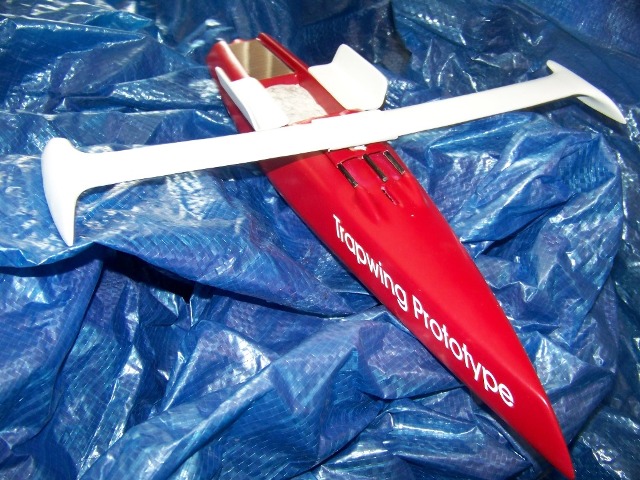 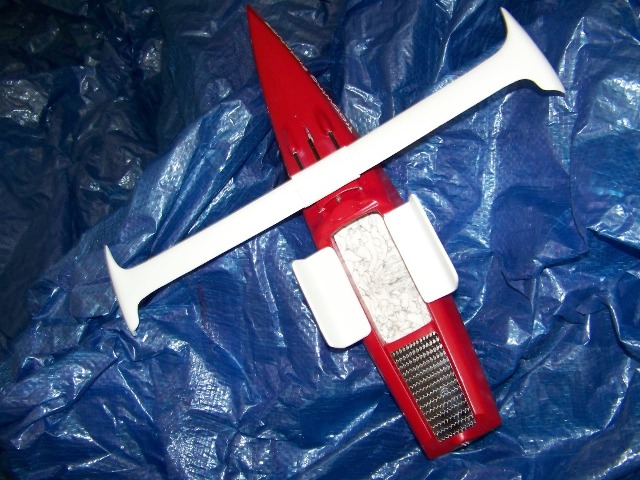  
|
Replies:
Posted By: Merlinboy
Date Posted: 11 May 10 at 7:41am
|
I don't get the wing thing?? You sit in the middle on a
chair, with a keel underneath and the boat foils??? So the wing is for what? Extra suitability? How does it work? you pull a string and it pulls the wing across for ballast? Is that not a bit cumbersome for a foiling flyer? Is there not going to be a huge amount of wind-age with that wing?? ------------- |
Posted By: Jon711
Date Posted: 11 May 10 at 8:20am
|
OMG Doug Lord is on here!!!! May have to go back to SA!!! |
Posted By: radixon
Date Posted: 11 May 10 at 8:23am
|
Looks to me like a cross between a Challenger Dinghy and the new K1 design. The rudder system looks like it will be out the water if there is too much lift and following on from MB, it looks like the wings will cause a balancing issue when foiling. There was a program on TV where a guy did an experiment trying to foil lift a pedelo/bike thing, (think it was bbc1 experiment program) anyway the conclusion being that too much weight stopped the thing from foiling as it wasnt able to get up to speed and foil. ------------- |
Posted By: Rupert
Date Posted: 11 May 10 at 8:50am
|
I'm guessing the idea is high performance for those of us who are too decrepid to sail moths, Musto Skiffs and the like. Isn't that what catamarans are for?! Will be an interesting concept if it works. I'm not sure a small model is going to prove it, but at least someone on here (and I include me in the masses) is doing more than doodling on paper/playing on a cad programme. Reminds me a little of the strange ideas that came from the AYRS pamphlets in the 1960's and 1970's. Most of those ideas fell by the wayside, but a few, such as foils and wing masts, have developed into things that work, as material science caught up. I'm not an SA person, though I have heard the Doug Lord name before...Remember, this is on the dinghy devlopment thread, not banter... ------------- Firefly 2324, Puffin 229, Minisail 3446 Mirror 70686 |
Posted By: alstorer
Date Posted: 11 May 10 at 8:56am
|
He managed, in a rare event, to get banned from SA... he's been promoting this idea for years, but never ever seems to get closer to actually building a full sized prototype. He once built a boat that he claimed did actually foil, but there's was no-one around to see it do so, and he sold off the bits (the hull now gets used as an ultra-stable windsurfer trainer I think). Criticise the "science" or "numbers", and you'll get personal abuse, sometimes via PM. ------------- -_ Al |
Posted By: Guest
Date Posted: 11 May 10 at 9:02am
|
Who wants to sit still in a chair in the middle of the boat, no thanks it's meant to be a physical sport. ------------- |
Posted By: radixon
Date Posted: 11 May 10 at 9:32am
|
http://www.intersail.co.uk/forum/forum_posts.asp?TID=1024&KW=Doug+Lord - Been here before Clicky well 5 years ago anyway.............. ------------- |
Posted By: Andymac
Date Posted: 11 May 10 at 9:42am
|
Sorry, doesn't do anything for me. Looks like the paralympics on 1st April. Ballast and foiling seem to be a little contradictory, although I concede that Hydroptere probably isn't featherweight. Anyway, good luck Doug with your endeavours. Whether or not anything comes of it, it sometimes pays to think outside the box. You may discover something extraordinary on your journey. |
Posted By: Jon711
Date Posted: 11 May 10 at 9:44am
Fair comment Rupert, but, just wait... As I am also sure the other SA people will vouch for...... |
Posted By: Wee Man
Date Posted: 11 May 10 at 1:07pm
| Sit in foiler has been done before, Hobie Trifoiler. |
Posted By: radixon
Date Posted: 11 May 10 at 1:58pm
Wasn't there one at Datchet sitting idol near the club house for a while? ------------- |
Posted By: blaze720
Date Posted: 11 May 10 at 3:30pm
|
Come along .... it must be GRF in reality.... Seperated at birth - surely ? Mike L. |
Posted By: alstorer
Date Posted: 11 May 10 at 3:41pm
|
No, Doug is quite real and very much not GRF. ------------- -_ Al |
Posted By: Guest
Date Posted: 11 May 10 at 3:59pm
|
yeah they look verry different ...
------------- |
Posted By: Doug Lord
Date Posted: 11 May 10 at 4:27pm
|
The foils shown on the model are for "Foil Assist"- not full flying like a Moth -though that is possible in a "turbo" version. Their purpose is to reduce wetted surface so that planing can begin earlier as wellas to improve handling and especially to improve pitch control.
The boat has two seating options: one where the crew sits down inside the boat and "plug-in" seats on either side(that I personally prefer)-both illustrated in the pictures. The WING slides side to side either manually or electrically faster than a trapeze crew can move. Inside the sealed wing is an adjustable amount of lead that moves simultaneously with the wing. ---------- The point of the boat is to allow people who are tired of running back and forth and(potentially) disabled people to sail fast in a self -righting/easily righted boat. For able bodied sailors no keel ballast is required; for disabled sailors the keel ballast in combination with the buoyancy in the sealed wing makes the boat self-righting with no crew input. -------- I'm being helped on this project by a disabled sailing Coach and 2.4 meter builder, Mark Bryant &nbs p; ( www.markbryantsailing.com ) . The first prototype is being built using the hull from my first foiler....There is plenty of work to do to prove the concept in full size sailing though it has been exhaustively tested in models over ten years. |
Posted By: alstorer
Date Posted: 11 May 10 at 4:29pm
|
Come back when you have shots of the full sized prototype. Doesn't have to be sailing- we'd love to see build shots too. But not not just old photos of your "foiler". Until then all you have is a shiny model and bluster. ------------- -_ Al |
Posted By: Doug Lord
Date Posted: 11 May 10 at 8:07pm
============== I'm back now ,Storer. And no thats not all I have. I have one of the most unique, fast dinghy concepts ever developed. I have a concept that could open fast planing sailing to a whole new range of people allowing older people, lighter people, heavier people, out of shape people and disabled people to sail very fast. It is a new way to sail that is not available now anywhere at any price. And with help from people like Mark and interest from people like Dave Trude(dawg-SA's webmaster) this concept shows a lot of promise. 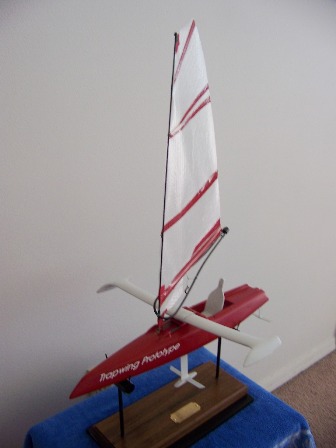 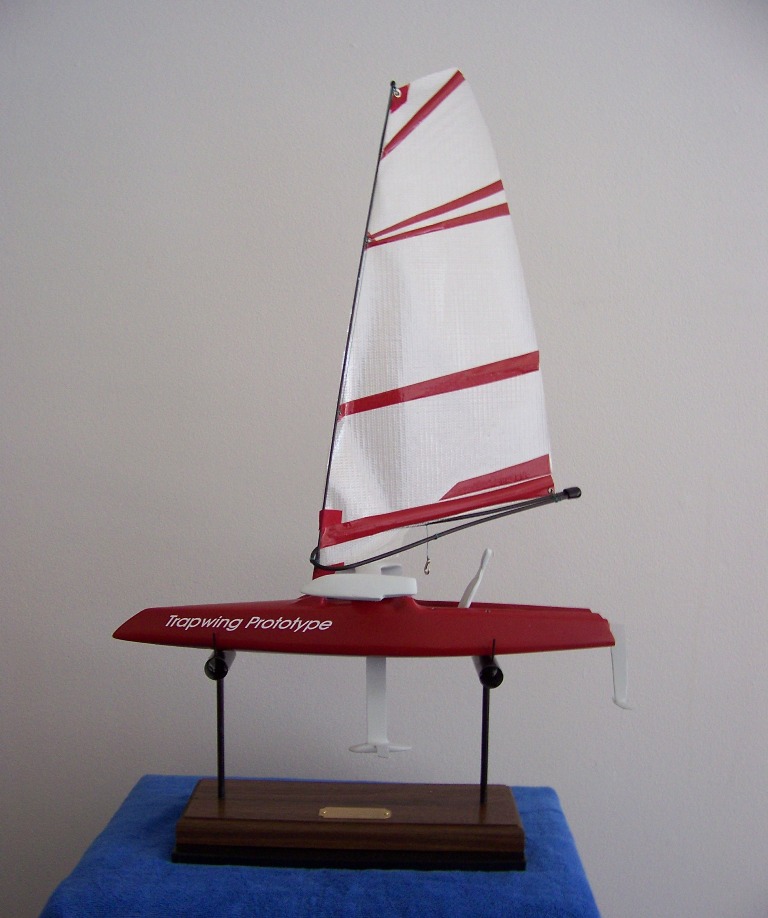 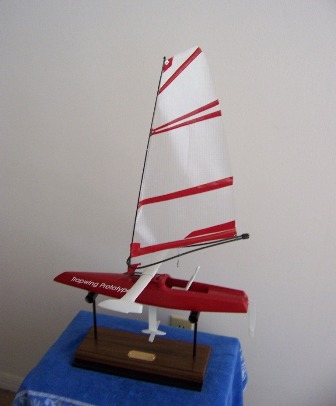 
|
Posted By: Villan
Date Posted: 11 May 10 at 8:51pm
You mean "Interest" in the sence of "Interested enough to listen to hundreds of people on SA and ban you" ... Go home Doug, give it up, take up Lawn Bowls, and let someone who knows what they are doing design a "peoples foiler" (The people with the money and b**locks to build, sail, and take photos of them!) ------------- Vareo - 149 "Secrets" http://www.TandyUKServers.co.uk" rel="nofollow - TandyUK Servers |
Posted By: alstorer
Date Posted: 11 May 10 at 9:12pm
I get email:
------------- -_ Al |
Posted By: William H Frump
Date Posted: 11 May 10 at 9:23pm
|
Nice photos doug, can't quite read what is says on the plaque. I'm guessing something like, Foiling, a revolution, MY REVOLUTION. If you send me your address I'll stick an action man in the post so when your playing with your model boats in the bath you'll have someone to share the dream with. ------------- blah blah blah |
Posted By: Doug Lord
Date Posted: 12 May 10 at 5:36pm
|
from boatdesign.net :
Charles Herreshoff and Sons-on-deck ballast! ------------------------------------------------------------ -------------------- I just found some details about a story that I'd heard a few years ago-about "Herreshoff" experimenting with on-deck sliding ballast. This is from a book "Herreshoff Sailboats" by Gregory O. Jones and lays out some interesting details of the first recorded use of on-deck iron sliding ballast that I've been able to find. Apparently, new rules and sheer terror got in the way of further development though the two boats that used this form of ballast were very fast. The Seawanhaka Corinthian Yacht Club, formed in 1871 banned movable ballast. Charles Herreshoff built four "Julias" ,the second was outfitted with an athwhartship track for 550lb. of iron ballast to slide. The method was to release the ballast from the windward side and allow it to slide to leeward just as the boat tacked. Charles designed a larger boat "Kelpie" that his two sons built that used a larger sliding ballast system-1000lb! Kelpie was very fast. This stuff is exciting to read about and one can only speculate how these systems might have been refined over the years. I think modern versions of systems like these using lead or water have a tremendous potential in high performance boats of all sizes. I'm going to concentrate on small boats where I see an exciting opporunity to explore this interesting technology. |
Posted By: Guests
Date Posted: 13 May 10 at 1:02pm
|
Hi Doug, This seems like a concept boat more than an actual design - like the concept cars show at car shows. Great to look at, plenty of glimpses to the future, but not a working solution. A few random thoughts: a. A disabled boat needs more than to be able to recover from knockdown. It must knock down in the first place. The thought of sitting in a fixed chair, on my side, in the water does not appeal. b. the on deck ballast is the logical extension of a canting keel - far more effective generation of righting moment. The downside is that extra righting moment is also potentially extra heeling moment if the wind backs or the system gets jammed. c. an alternative, less efficient but safer, solution is to have sliding buoyancy rather than sliding ballast. Obviously it would slide to leeward not windward. But then the temptation is to fix the buoyancy and hey presto - a multihull! d. I lke the idea of a singlehanded sit in boat that is more exciting than a 2.4m. As shown however, the design looks too extreme. e. I think the idea merits further exploration, but would be tempted to put the majority of ballast in the keel (boringly conventional!), but use the trapwing to reduce the amount of keel ballast required (and hence total displacement). rather than the majority in the wing with the keel as a sort of safety back up. f. I would be tempted to go for a more conventional, fractional jib, as gust response may be very important on a boat like this. g. 'Foil assist' is an area with huge potential for speed increases, but with downsides in cost and, possibly, manoeuvrability. There was a really interesting article in Y&Y a couple of issues back where Jo Richards (Pico, Dead Cat Bounce, Full Pelt etc) is quoted as believing that there is much to learn from the appendages modern F1 cars have in terms of flow alignment and pressure control. I suspect the concept is too radical, difficult and impractical to get much foothold in the UK dinghy scene. But please keep the development going and prove all the ney-sayers wrong. Anything to shut Chris O up for a while! |
Posted By: Rupert
Date Posted: 13 May 10 at 1:35pm
|
I too wonder whether experimenting with each concept in turn will give a better idea of how each works - too many variables currently. The idea of a sliding Ama could work - you could have it to leeward as a sit in disabled sailing type boat or to windward as a Proa type balancing act. ------------- Firefly 2324, Puffin 229, Minisail 3446 Mirror 70686 |
Posted By: G.R.F.
Date Posted: 13 May 10 at 2:35pm
|
What is it with you people?
Can't we just take this at face value for a bit? It's in the right section. The Guy has built a model which is more than I've managed so far even though I've got all the bits to make the model at home and they've been there for months now. I notice it's the commercial pimps straight in there to denigrate the man. There has been no foul language, no abuse, other than from some of you lot, which by now I would have had to respond to. I think it's an interesting concept, not least because it appears to give an easier entry to learning to foil, which, I for one would like to give a go, there is in fact an interesting article by a lass on Y&Y this month who visited Mar Menor on a course. Trouble is the course costs €750 which personally I baulk at paying. Why not let it run it's course, don't prejudge and be civil for a change, there must be lots of lurkers that have no idea of the history, so lets not let the usual subjects put up the sort of resistance I got when I first arrived, then lets see if he can survive three bans and come back.. ------------- https://www.ease-distribution.com/" rel="nofollow - https://www.ease-distribution.com/ |
Posted By: Doug Lord
Date Posted: 13 May 10 at 3:12pm
|
Peaky, one of the critical aspects of this design is that the WING is sealed 100%. If you moved the ballast max to windward in no wind the boat would tilt over but the massive buoyancy of the sealed wing would keep it upright.
The worst case scenario is with the WING extended max to weather and the boat gets a hand of God gust that knocks it flat. Within less than a second the weight would be centered and a large portion of the buoyant wing extended to leeward(down)pushing the boat upright(assuming that the sails are not cleated!).The prototype hull model shown was built ON the model of my 16 foot foiler that is giving its life that this concept may be tested-in other words the proto is half done and I'm hoping the rest of the conversion can start in a couple of months. There are some compromises in using the existing hull like the fact that it is a bit narrower than a production version might be. But then again it is a proto and we might like it narrow. Some notes: 1) a major element of this design is the athwartship PIVOT of the wing which is fully adjustable. It serves to keep the lee side of the WING out of the water and the ballast low to windward(when you want it low).More detail here: www.boatdesign.net (sailboats) 2)Foil assist is a critical element of the design and the foils will be optimized in tow tests so that we know that they work efficiently. 3)The concept is quite broad and can be used on virtually any size boat from 12' on up. 4)The most important single element of this design is the WING: --a. it is 100% sealed with access to change ballast. --b. the lead sits in a tray that slides inside the wing.If we used a fixed wing(like a tri crossarm)it would have to be twice as long for the same RM. If we used water the WING would have to be ten times as big. Lead is best at this size, however, water would work perfectly on a 60' version... |
Posted By: ColPrice2002
Date Posted: 13 May 10 at 3:40pm
|
HI, Not sure about the "The worst case scenario is with the WING extended max to weather and the boat gets a hand of God gust that knocks it flat". From last week-end (inland lake) the worst was helm & crew sitting out hard to windward, then a 10 degree (or larger) wind shift which had both of us climbing up the hull (inside). The ex-windward gunwhale was under water at that time. Obviously, centering the ballast under thos conditions will be "uphill" Colin |
Posted By: Laser 173312
Date Posted: 13 May 10 at 3:51pm
|
and it's only a 2 day course. I thought it was very steep.
------------- |
Posted By: Ross
Date Posted: 15 May 10 at 2:35pm
|
I can't see it working. On a trapeze you can move your weight in, out, backwards and forwards in an instant. Good for start lines, emergancy manovers, crash tack and gybes etc etc. How much inertia (or is a momentum?) will they carry through on a tack or a gybe?! Imagine lead weights swinging around in a fleet on a start line. Keel boats that plane already exist. You probabley better off sticking the weights on the end of the plank thing on the bottom of the keel. ------------- Ross If you can't carry it, don't sail it! |
Posted By: Doug Lord
Date Posted: 15 May 10 at 6:53pm
============== Well, its already worked for over ten years on models where the reaction time has to be faster than on the full size boat. The system for the full size boat will move the ballast faster than a person on a trapeze. 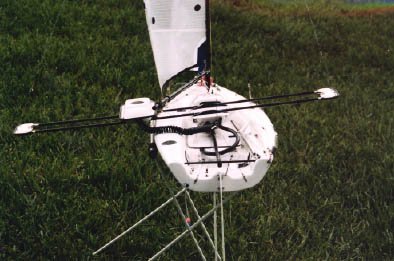 
|
Posted By: winging it
Date Posted: 16 May 10 at 8:12pm
|
I worry about thiis as a possible boat for the disabled. Firstly, as has been said, if the boat suffers from a knock down being self righting isn't a lot of help for the person trapped in the cockpit, or worse, possibly flung out of it. Secondly, one of the biggest issues facing the disabled sailor is being able to actually get into the boat. This means a boat that can be launched from a beach or slip is a much preferred option, unless you have a hoist on the end of your jetty. If Doug's boat has either a keel, or foils, or both, then beach/slipway launching becomes difficult. The reason why the challenger trimaran is currently the disabled sailors preferred multihull is that although basically very simple, it can perform pretty well in even quite rough conditions and is actually quite stable - capsizes are incredibly rare. I would think if these sailors wanted any kind of accessory or modification to the boat it would be an assy kite, not foils. ------------- the same, but different... |
Posted By: Doug Lord
Date Posted: 16 May 10 at 9:21pm
|
The challenger is a great boat except for the "incredibly rare" capsize-which I would imagine would be highly likely to have a bad result. For disabled use, the Trapwing is designed to be self-righting-if a boat that is NOT self-righting is ok for disabled sailing then surely one that is should be ok. Interestingly, if the Trapwing was sailed with the same SA as a Challenger ,it would be over 75lb(34kg) lighter
and still selfrighting! This boat is specifically designed to be launched from a beach using a trailer and dolly-the ballast keel w/foils is transported retracted as is the rudder+foil. |
Posted By: Doug Lord
Date Posted: 18 May 10 at 10:41pm
As I said earlier, the boat is designed to be easily trailered with a dolly for beach launching. The Wing pivots and slides slightly to the side. The daggerboard-with foils and with or without ballast is retracted. Same with the rudder. 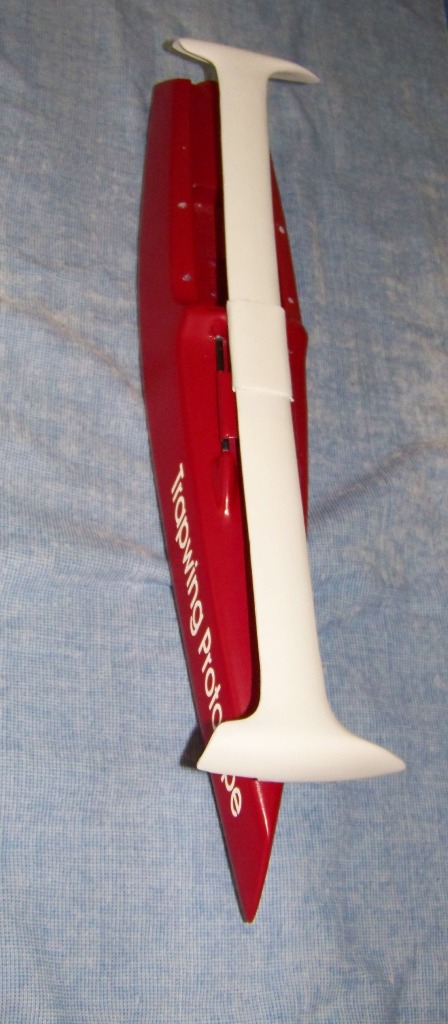
|
Posted By: Adam@LDC
Date Posted: 19 May 10 at 7:51am
|
Doug do these models sail. As the pics all seem to be on dry land. It
would be nice to see how they sit in the water and sail. And are there any videos to see how it tacks with the weight moving etc. ------------- Retail Manager, LDC Racing Sailboats |
Posted By: Doug Lord
Date Posted: 19 May 10 at 2:26pm
Adam, the Trapwing prototype model is only 17" long and is not a sailing model. However, from 1995-2005 I developed and extensively tested a number of RC sailing models using the "Trapeze Power Ballast System". This was a movable ballast system similar to that to be used on the Trapwing. The model system used a "rack" where the battery+ballast slid on two carbon tubes. The battery moved as the rack moved. The Trapwing system is a 100% sealed wing with the ballast inside; the wing and the ballast move simultaneously.In 10 years of testing we never had a failure of the system or a control issue of any kind.....There was video but when the microsail site was taken down it was not saved.
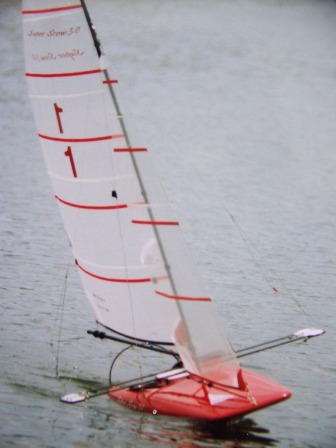 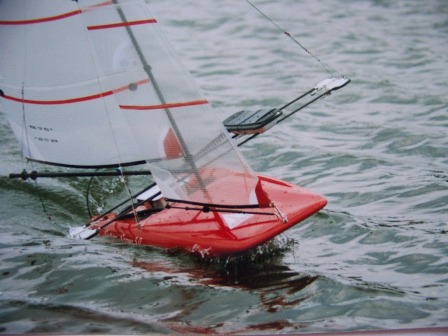 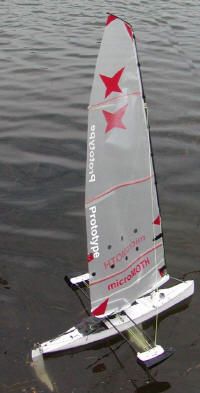 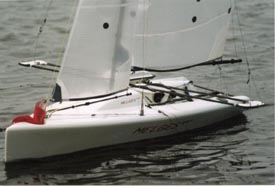 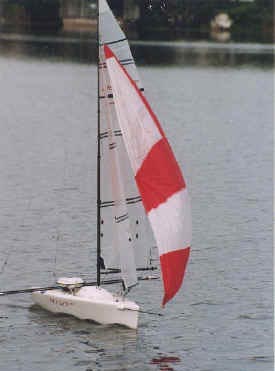
|
Posted By: laser193713
Date Posted: 19 May 10 at 6:38pm
|
Does it now? how do you plan to do that in fullsize with fittings that provide enough strentgh and are removable like this and can be lifted for recovery by a disabled sailor. Either you are going to need a heavy winch to lift the keel and foils or some magic that I dont know about. The boat must me sailable with the keel and foils up remember do deal with long shallow angle slipways. I am scared about what would happen in a moth style nosedive, this is bound to happen in any sort of wind or chop and you have seen how far a moth helm flies when his boat stops dead in the water from 25knots! Either the disabled helm would do this or they would be strapped in and given whiplash. Its a nice idea, works well on models but I think strapping a disabled helm into it would be a very very dangerous thing to do! ------------- |
Posted By: RS400atC
Date Posted: 19 May 10 at 6:59pm
|
Doug, Have you done any calculations regarding Sail Carry Power (aka righting moment), weight and wetted area? What kind of design windstrength is it aimed at? 80kg of ballast is not much in relation to the all up weight. You could compare the ratios with those for existing craft to indicate performance. I'm not involved with 'true' disabled sailors but I am involved with a keelboat class where many of the older sailors have physical problems but greatly enjoy sailing on a level basis with fit people. There is more to sailing (especially racing) than high performance. Also people who can't walk are as individual as the rest of us (perhaps more so?), I would not generalise about what they all want. If you succeed in fulfilling someone's dream to sail faster, good luck! |
Posted By: RS400atC
Date Posted: 19 May 10 at 7:07pm
|
I think Geoff Holt, who I have met, capsized his rather publicly at the start of his round (most of) Britain escapade. Bit like the rest of us capsizing really. Embarassing but he got over it!
|
Posted By: Doug Lord
Date Posted: 19 May 10 at 7:11pm
---------------------- Do you know what causes "a Moth style nosedive"? This boat does not fully fly like the Moth does nor does it have a wand altitude control system like a Moth does(that causes a crash when it pops out of the water springing forward and raising the flap on the main foil and then splat!) Further, theoretically, the foils being used for foil assist will 100% prevent any kind of pitchpole. Practically, there is no way to know without exhaustive testing of the prototype. The boat will be developed with the help of at least one disabled sailor and one of the top disabled coaches in the USA. These guys will help make the boat as user friendly to disabled sailors as is possible. As far as raising the keel goes that can be done in a number of ways-using the vang, electrically or by hand for some people. The attachment system for the wing will be well engineered and proven by extensive testing.Pivoting it and sliding it sideways requires very,very little force. The boat will be able to be sailed with the foils retracted but not with the wing 'scissored'. It may be able to be launched with the wing pivoted a bit but not sailed that way. |
Posted By: Doug Lord
Date Posted: 19 May 10 at 7:23pm
====================== Thanks. The target SCP/Total Weight for the turbo version is 30%. That kind of power is not critical though since this concept covers a broad performance spectrum. Testing the prototype is the key to finding the ideal production boat characteristics. Keep in mind that while it is critical to me that a version(or configuration of the same boat) of the concept work to provide disabled sailors a very fast, safe ride the concept is not limited to disabled sailors. Some high powered versions may be too much for disabled sailing. Lots of potential for a new kind of performance sailing.... PS- don't forget that the wing is sealed and would resist capsize with a huge amount of force even with the ballast on the wrong side. |
Posted By: alstorer
Date Posted: 19 May 10 at 8:55pm
|
so the wing itself is buoyant? ------------- -_ Al |
Posted By: Doug Lord
Date Posted: 19 May 10 at 9:47pm
========================== Yes |
Posted By: Doug Lord
Date Posted: 19 May 10 at 10:13pm
Pictures of wing deployed to port. One of the key elements in the design is that the wing pivots adjustably athwartship. This allows the lee side to stay clear of the water, the weight to stay low and/or the boat to heel a bit with the wing level or a bit lower. When the weight is centered the tips of the wing can be supported by shock cord initially allowing the wing to pivot when the weight is moved just a little. The amount of pivot is adjusted by adjusting the line that supports the end of the wing-see rough sketch below.
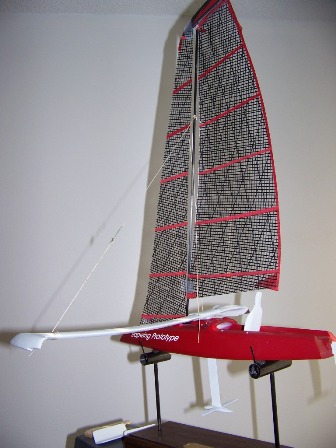 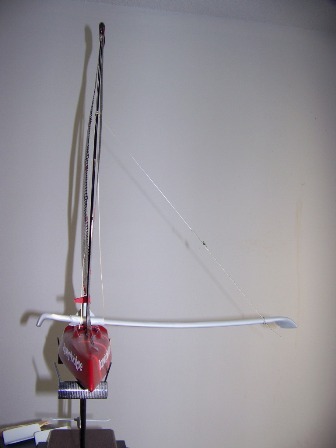  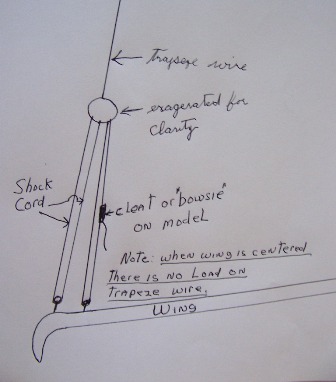
|
Posted By: radixon
Date Posted: 20 May 10 at 8:40am
|
You have had 15 years of thought behind this, personnally I would of started a prototype full size model with my beer fund. Have you considered doing this, I know it costs money but unless you dont have anything to show, its not going to get off the ground. If you speak to Rodney (D-One) and Mike (Blaze) who are on here, they may be able to point you in the right direction. ------------- |
Posted By: alstorer
Date Posted: 20 May 10 at 11:09am
|
radixon: he's based in Florida. The Florida based 2.4mr builder that he claimed to be working with said that he'd be happy to build a prototype. There really are no excuses... ------------- -_ Al |
Posted By: Doug Lord
Date Posted: 20 May 10 at 4:49pm
================ Building of a full size prototype is the priority..... |
Posted By: Doug Lord
Date Posted: 01 Jun 10 at 10:29pm
|
Mark Bryant( [/url]http://www.markbryantsailing.com - ) ,great sailor, disabled sailing coach, and someone who has encouraged me a great deal on this project has suffered a horrible tragedy that no one should ever have to go thru: he has lost his 29 year old son.
My condolences to him and his family in this awful time. |
Posted By: Campbugler
Date Posted: 20 Aug 16 at 9:47pm
|
Doug,
Just got my hands on Melges 24 rc with power ballast. Appears in exc. shape. Any recommendations for battery replacement? If I wanted to sail without power ballast what would I have to add to keel. Have extensive dinghy and offshore experience. Currently sailing a Banshee. Contemplating getting her foiling. Thanks Phil Vandenberg Santa Cruz,Ca |
Posted By: Riv
Date Posted: 24 Aug 16 at 9:29pm
|
Is this a development of the foiler 21? |

